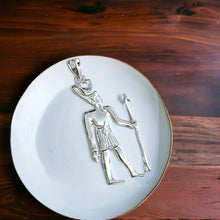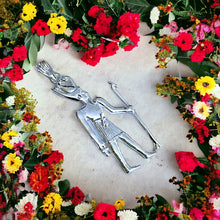
The Silver God Amun Large Pendant Necklace embodies the majesty of ancient Egyptian culture. Inspired by the deity Amun, symbolizing creation and divine power, this pendant pays homage to millennia-old craftsmanship and spiritual significance, offering a timeless blend of history and elegance in modern jewelry design.
- History: Inspired by ancient Egyptian deity Amun, symbolizing power and protection.
- Spiritually: Represents divine energy, strength, and guidance.
- Talisman: Believed to ward off negative energies and offer spiritual blessings.
- Handmade: Crafted with care and attention to detail for authenticity.
- Healing: Thought to promote mental clarity, emotional balance, and inner peace.
- Material: Sterling silver, renowned for its purity and durability.
- Symbolism: Amun's presence signifies authority, creativity, and wisdom.
- How to Wear: Simply slide onto any chain up to 5mm thickness for effortless style.
- Ideal Gift: Perfect for those seeking spiritual connection or admiration of Egyptian culture.
History Side For Those Who Are Interested
Amun, one of the most significant deities in ancient Egyptian religion, evolved over millennia, reflecting the cultural and political changes of Egypt's history.
The worship of Amun can be traced back to the Early Dynastic Period (c. 3150–2613 BCE), where he was often depicted as a local god of air or wind in the region of Thebes (modern-day Luxor). During the Middle Kingdom (c. 2055–1650 BCE), Amun gained prominence as a member of the Theban Triad, alongside his consort Mut and their son Khonsu, representing kingship, motherhood, and the moon, respectively.
However, it was during the New Kingdom (c. 1550–1070 BCE) that Amun rose to unparalleled prominence. Theban rulers, particularly those of the 18th and 19th dynasties, elevated Amun to the status of the king of the gods, often identifying themselves as his earthly representatives. Pharaohs such as Ahmose I, Hatshepsut, Thutmose III, and Ramesses II undertook extensive building projects in honor of Amun, erecting grand temples such as Karnak and Luxor.
Amun's significance extended beyond religious worship; he became synonymous with the state's power and authority. The wealth and influence of the Amun priesthood grew immensely, holding vast estates and controlling significant portions of Egypt's economy. The god's cult centers, particularly Karnak, became focal points for religious festivals, pilgrimage, and economic activity.
During the reign of Akhenaten (c. 1353–1336 BCE), Egypt witnessed a brief period of religious upheaval when the pharaoh attempted to replace the traditional polytheistic religion with the worship of the Aten, a solar deity. This period, known as the Amarna Period, saw Amun temporarily sidelined, with his temples defaced and his cult suppressed. However, following Akhenaten's death, his successors, notably Tutankhamun and the pharaohs of the 19th dynasty, restored the worship of Amun to its former glory.
The Third Intermediate Period (c. 1070–664 BCE) saw the decline of central authority in Egypt, during which Amun's priesthood at Thebes gained considerable autonomy and political power, effectively ruling Upper Egypt as the High Priests of Amun.
With the rise of the Kushite rulers of the 25th dynasty and later the Nubian pharaohs of the 25th dynasty, Amun was syncretized with the Nubian lion god Apedemak, further solidifying his role as a unifying force between Egypt and Nubia.
The influence of Amun persisted into the Late Period (c. 664–332 BCE) and the subsequent Ptolemaic era (c. 332–30 BCE), during which Greek and Roman rulers identified Amun with their own deities, such as Zeus and Jupiter, respectively.
Following the decline of ancient Egyptian civilization and the rise of Christianity, the worship of Amun waned, eventually fading into obscurity with the spread of monotheistic religions in Egypt. However, his legacy endures in archaeological remains, religious texts, and the enduring fascination with ancient Egyptian culture and mythology.















